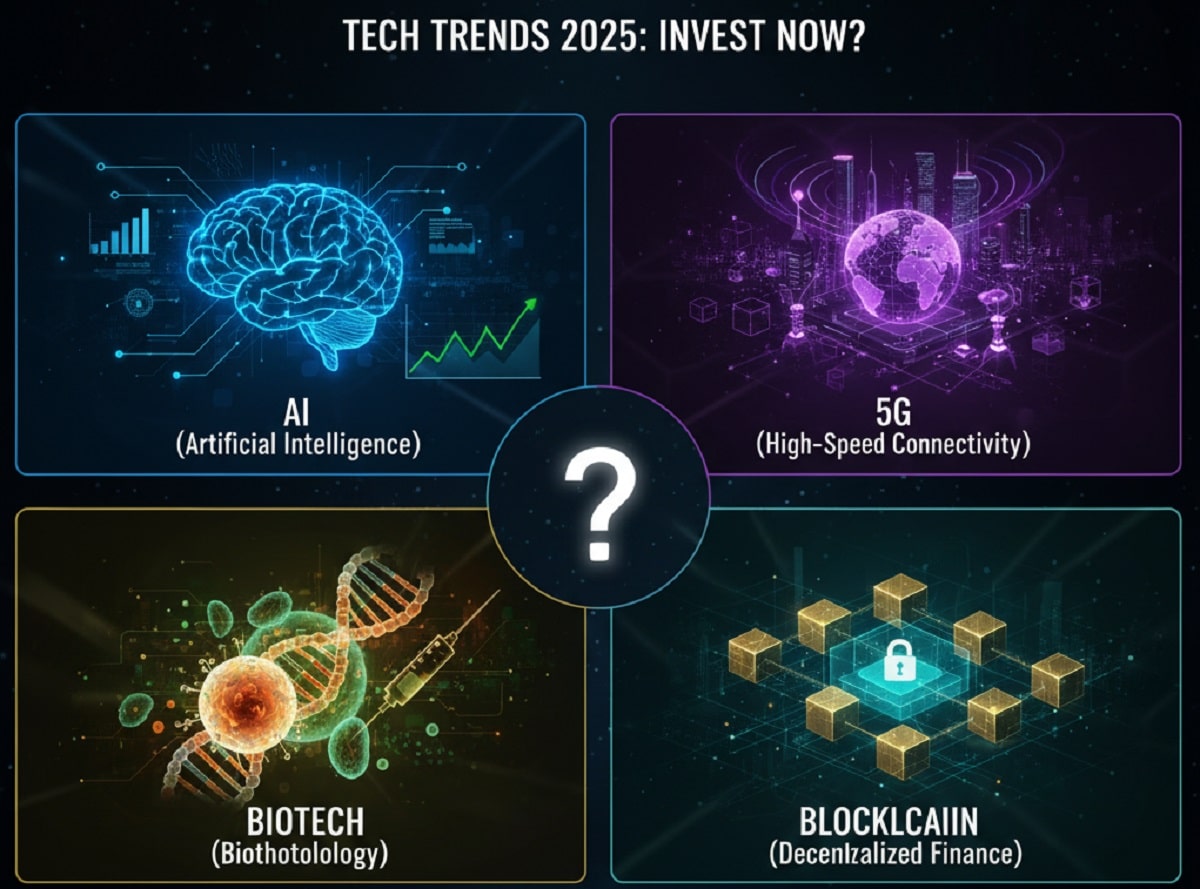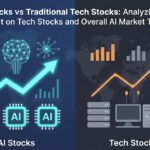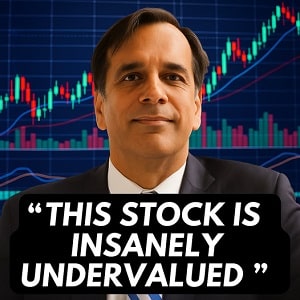Quick Takeaways for Investors in 2025
Q: Which tech trend has the biggest potential for investors right now?
A: All four — AI, 5G, Biotech, and Blockchain — are reshaping the economy. But AI infrastructure (chips, cloud, enterprise software) is pulling in the most serious money in 2025.
Q: Is AI investing still worth it after the hype?
A: Absolutely. The “chatbot craze” was just noise. The real wealth is in companies building the hardware and software backbone of AI.
Q: What makes biotech especially attractive this year?
A: Breakthroughs in CRISPR, mRNA, and AI-driven drug discovery are shifting biotech from speculation to real cures — and the upside is enormous.
Q: Is 5G old news, or still investable?
A: The hype cycle passed, but now 5G is powering self-driving cars, smart factories, and telemedicine. Early 6G groundwork is already happening.
Q: Has blockchain investing fizzled out?
A: The speculation cooled, but blockchain is quietly becoming the backbone of finance, supply chains, and even digital identity. Adoption is accelerating.
Q: Do I have to pick just one tech trend?
A: No. The winners will be select companies within each sector. Spotting those early is where the wealth is made.
Q: How do I know which specific stocks to buy?
A: That’s where research services like Jeff Brown’s Near Future Report matter — giving investors a shortcut to the companies best positioned to dominate.

The Real Problem Most Investors Face
Every investor I know has been burned by “trend chasing.”
Maybe you’ve been there too. You buy into the buzz — the hot stock everyone’s talking about, the sector CNBC swears is unstoppable. At first, it looks like you’re on the right track. But weeks later, the story cools, the hype shifts, and you’re left wondering why your “can’t-miss play” turned into dead money.
I get it. I’ve lived it.
Back in the dot-com boom, I poured cash into a handful of flashy internet names because they were in the headlines. On paper, I looked like a genius… until reality hit. Those same stocks tanked within a year, while the quiet players — the companies building the infrastructure — went on to mint fortunes for patient investors.
That lesson stuck with me.
The truth is this: the biggest wealth isn’t made by chasing the obvious hype. It’s made by spotting the right wave early — and riding it before Wall Street piles in.
That’s exactly the situation we’re in right now with AI, 5G, Biotech, and Blockchain.
These aren’t “maybe someday” technologies anymore. They’re here. They’re scaling. And they’re about to send a select group of companies into hypergrowth.
The question is: which trend — and which companies — should you be putting your money into right now?
That’s what we’re diving into today.
Trend #1: Artificial Intelligence Infrastructure – Where the Smart Money Is Flowing
When most people hear “AI investing,” they picture flashy apps: chatbots writing poems, tools generating images, or voice assistants that sound eerily human.
That’s fun tech. But here’s the truth seasoned investors understand: the real money isn’t in the apps — it’s in the picks and shovels.
Why Infrastructure Matters More Than Apps
Think about the California Gold Rush. Who got rich? Not just the miners. It was the people selling shovels, denim, and railroads.
The same dynamic applies to AI. Yes, there will be winners in consumer-facing AI apps. But the consistent, scalable, multi-billion-dollar opportunities are in:
-
Semiconductors – companies designing and manufacturing the chips that power AI.
-
Cloud infrastructure – hyperscale data centers enabling AI workloads.
-
Enterprise platforms – software providers embedding AI into mission-critical systems for business, finance, and healthcare.
These are the backbone businesses of the AI revolution. Without them, AI can’t scale.
Semiconductors: The “Arms Dealers” of the AI Boom
Let’s start with chips. Training large language models or running real-time inference requires unprecedented computing power.
That’s why demand for GPUs, TPUs, and custom AI accelerators has exploded. One leading chipmaker saw its stock price more than triple between 2022 and 2024 as every major AI company scrambled for their hardware.
But here’s the catch: while one name dominates headlines, it’s not the only play. Up and down the semiconductor stack, opportunities are opening:
-
Memory makers — DRAM and HBM providers are cashing in because AI workloads need massive high-bandwidth memory.
-
Networking specialists — chips that move data at lightning speed between processors are suddenly mission-critical.
-
Custom silicon designers — Apple, Google, Amazon, and Tesla are all building in-house AI chips, but they rely on specialized design software and fabrication tools from other firms.
The demand curve here is steep and persistent. Every new AI breakthrough requires more advanced silicon, and that means chipmakers become the arms dealers of the new economy.
Cloud & Data Centers: The Digital Landlords
Of course, chips alone don’t build AI models. They need to be housed, cooled, and scaled across global networks.
That’s where cloud giants and data center REITs come in.
Hyperscale operators are quietly expanding their footprint at record speed. Some are even designing custom data centers specifically optimized for AI workloads, with advanced cooling, fiber interconnects, and renewable energy sourcing.
And don’t overlook the “picks and shovels” here either: companies making cooling systems, power management solutions, and high-speed fiber are suddenly in huge demand.
This is an ecosystem play, not a single-stock story.
Enterprise AI Platforms: The Hidden Growth Engine
Here’s a less obvious but just as powerful angle: enterprise software.
Businesses aren’t just dabbling in AI — they’re embedding it into everyday operations:
-
Banks are deploying AI for fraud detection in real time.
-
Manufacturers are using AI to optimize supply chains and reduce downtime.
-
Healthcare systems are running AI-powered diagnostics that catch issues doctors miss.
The companies selling enterprise AI platforms are building recurring revenue models. Instead of a one-time app download, these are long-term contracts with Fortune 500 clients.
That’s sticky revenue. And sticky revenue means resilience even if broader tech markets wobble.
Case Study: How “Boring Infrastructure” Creates Massive Returns
Let me share a quick story.
A friend of mine was obsessed with AI chatbots back in 2023. He bought into a handful of speculative app makers. Some spiked briefly, but most fizzled as competition exploded.
Meanwhile, I put capital into a data center REIT and a chip stock that barely made headlines at the time. Fast-forward 18 months: his portfolio is down, mine is up triple digits.
Why? Because infrastructure is the toll road every AI player has to drive on.
When you own the toll roads, you don’t care which app wins. You profit no matter what.
The Obvious Investor Question: “Isn’t It Too Late?”
I hear this a lot: “AI stocks already ran up. Did I miss the boat?”
No. You haven’t.
Yes, the early hype wave rewarded the fastest movers. But step back and think about the timeline: AI isn’t a one-year fad. It’s a decade-long transformation, reshaping everything from office software to medicine to defense.
Where are we right now? Closer to inning two than inning nine.
Infrastructure demand isn’t peaking — it’s just beginning. Every new AI model is bigger and hungrier. That means continuous upgrades in chips, data centers, and software systems.
Think of it like the internet in 2000. Sure, some dot-com names flamed out, but the companies laying fiber, building routers, and powering cloud computing became trillion-dollar giants.
That’s the stage AI infrastructure is at right now.
What This Means for Investors
If you’re serious about AI investing, don’t just chase the apps everyone’s talking about. Look for companies positioned as essential infrastructure providers:
-
The chipmakers designing next-gen GPUs, TPUs, and custom silicon.
-
The suppliers enabling data center growth — from cooling to fiber optics.
-
The enterprise platforms embedding AI into global business operations.
These aren’t speculative moonshots. They’re the foundational plays of a multi-trillion-dollar wave.
And the best part? Most retail investors are still chasing the wrong side of the trade.
That’s where disciplined research comes in.
Because yes — there are massive winners here. But there are also plenty of overhyped names with no staying power.
Spotting the difference is the difference between a portfolio that compounds wealth for years… and one that rides the hype rollercoaster down.
Trend #2: Biotech Breakthroughs – From Hype to Real Cures
For years, biotech investing felt like a lottery ticket.
Investors would jump into small-cap names promising miracle drugs, only to see the trials fail, the FDA reject the treatment, and the stock collapse overnight.
That’s why many traders wrote biotech off as “too risky.”
But 2025 is different. This isn’t just about drug speculation anymore. It’s about a convergence of science, technology, and AI that’s changing the entire landscape of healthcare.
We’re not talking about managing diseases. We’re talking about erasing them.
And that shift creates the kind of asymmetric upside investors dream about.
Why Biotech Is Entering a “Golden Decade”
Three forces are colliding right now, and together, they’re unlocking breakthroughs at a pace the industry has never seen before:
-
CRISPR and Gene Editing – Scientists can now “cut and paste” DNA like software code, targeting genetic diseases at the root.
-
mRNA Technology – Once unproven, it’s now validated by global vaccine rollouts, and companies are racing to apply it to cancer and rare diseases.
-
AI-Powered Drug Discovery – Models that once took years and billions of dollars to test can now be simulated in silico in a fraction of the time.
This trifecta is slashing costs, shortening development timelines, and — most importantly — delivering real cures.
For investors, that means biotech is no longer a roulette wheel. It’s becoming one of the most powerful wealth-creation engines of the next decade.
CRISPR: Rewriting the Blueprint of Life
CRISPR technology is one of the most jaw-dropping scientific advances of our lifetime.
Imagine being able to identify the typo in someone’s genetic code and simply delete it.
That’s what CRISPR does. And we’re already seeing real-world applications:
-
Trials have shown CRISPR can effectively cure sickle cell disease — a painful, lifelong condition.
-
Researchers are targeting forms of blindness, muscular dystrophy, and even cancer at the genetic level.
-
Some startups are now working on in vivo editing — meaning they can deliver CRISPR directly inside the body, not just in a lab setting.
This isn’t science fiction anymore. These are clinical results.
The companies pioneering CRISPR therapies are on the cusp of creating a new healthcare paradigm. For investors, that means early positioning in the right names could be like getting into Apple before the iPhone.
mRNA: The Platform Play
Before 2020, most investors had never heard of mRNA technology. Then came the COVID vaccines, which put mRNA on the global stage.
The key insight? mRNA is a platform.
Once you know how to encode instructions for the body to create one protein, you can reprogram it to make others.
That opens the door to a pipeline of treatments far beyond vaccines:
-
Cancer therapies that train the immune system to recognize and destroy tumors.
-
Rare disease treatments targeting conditions with no existing cures.
-
Universal flu vaccines that could end seasonal outbreaks.
Big Pharma knows this is the future. Billions of dollars are flowing into mRNA research partnerships and acquisitions.
For investors, that means the leading mRNA players are not just one-hit wonders — they’re platform companies with pipelines that could span dozens of blockbuster drugs.
AI in Drug Discovery: Compressing Decades into Months
Here’s the piece most investors overlook: biotech is no longer just biology. It’s computer science.
Developing a new drug traditionally cost over $2 billion and took 10–15 years. Most candidates failed in trials.
But with AI, the process looks completely different:
-
Algorithms can scan vast libraries of molecules and simulate their interactions with the human body.
-
Models can predict side effects and efficacy before a single human trial begins.
-
Entire stages of the process are collapsing from years into months.
One startup used AI to identify a potential new antibiotic in just 48 hours — something that once would have taken years.
This efficiency doesn’t just accelerate cures. It makes the economics of biotech far more attractive, reducing risk and increasing ROI.
Why 2025 Is the Tipping Point
So why now? Why is biotech hitting escape velocity in 2025 specifically?
Three reasons:
-
Regulatory Momentum – The FDA has already approved multiple gene-editing and mRNA-based therapies. That regulatory “green light” accelerates adoption.
-
Capital Inflows – Institutional money is rotating back into biotech after years on the sidelines. Hedge funds and sovereign wealth funds see this as the next growth wave.
-
Public Awareness – The pandemic made the world realize just how fast science can move. Patients, doctors, and investors are now demanding faster innovation.
Combine those forces, and you get a once-in-a-generation setup for biotech investing.
Case Study: From $5 to $300
Here’s a quick illustration.
One small biotech focused on rare diseases was trading at just $5 a share in 2017. By 2021, after announcing positive trial results for a breakthrough therapy, the stock exploded to nearly $300.
That’s a 6,000% return.
Of course, not every biotech will deliver numbers like that. But the potential for triple- or even quadruple-digit gains is real — especially when you position before Wall Street piles in.
The Risk Factor (and How to Handle It)
Now, let’s be real. Biotech isn’t risk-free. Trials fail. Stocks can swing wildly.
But here’s the shift: in 2025, you don’t have to gamble on tiny, unproven names.
You can focus on:
-
Established biotech firms with multiple therapies in the pipeline.
-
Platform players with CRISPR or mRNA technology applicable across dozens of diseases.
-
Companies partnering with Big Pharma (reducing capital risk).
In other words: you don’t have to swing for the fences on every trade. You can build a diversified biotech basket with asymmetric upside and managed downside.
What This Means for Investors
If you’ve ignored biotech in the past, 2025 is the year to pay attention.
We’re moving from “maybe someday” to real cures hitting the market.
That changes the game entirely.
-
CRISPR is rewriting genetic destiny.
-
mRNA is a universal platform for vaccines and therapies.
-
AI is compressing decades of R&D into months.
For investors, that means opportunity unlike anything else in the market right now.
The key is not chasing hype, but identifying the companies with the right tech, the right partners, and the right path through trials and approvals.
That’s where research services like Jeff Brown’s Near Future Report provide the edge — spotlighting the real players before they hit the mainstream.

Trend #3: 5G and 6G Connectivity – The New Digital Highway
When 5G first hit headlines, the hype was impossible to escape. Carriers promised lightning-fast downloads. Analysts predicted entire industries would transform overnight.
Then reality set in. Your phone got a little faster. Maybe your video calls dropped less often. But the “revolution” most people expected? It felt like a letdown.
That’s why many investors walked away from 5G stocks disappointed.
But here’s the kicker: the real revolution was never about streaming movies faster on your phone. It’s about the industrial and infrastructural applications of 5G — and those are hitting scale in 2025.
Even better? While everyone else is distracted, the groundwork for 6G is already being laid.
That means we’re staring at one of the most powerful — and overlooked — tech investment waves right now.
The Real Power of 5G (and Why It Took Time)
To understand where we are now, you have to see why 5G looked like a dud at first.
Rolling out a nationwide 5G network isn’t like flipping a switch. It required:
-
Billions in infrastructure spending (towers, small cells, fiber backhaul).
-
Spectrum auctions and regulatory approvals.
-
Years of device upgrades before consumers even noticed.
That lag created frustration for investors. But behind the scenes, carriers and equipment providers were building the digital highway that industries are now driving on.
In 2025, we’re finally seeing what 5G was always meant to do.
The Industrial Applications Driving Demand
Here’s where the story gets exciting.
5G isn’t about your Netflix app. It’s about enabling mission-critical systems with ultra-low latency and high reliability.
Industries adopting 5G right now include:
-
Autonomous Vehicles – Self-driving cars need to process and share massive amounts of data in real time. 5G makes that possible.
-
Smart Factories – Industrial IoT sensors track equipment, predict failures, and optimize workflows. 5G delivers the bandwidth.
-
Healthcare – Remote surgeries, telemedicine, and diagnostic devices require rock-solid, high-speed connections.
-
Logistics & Shipping – Real-time tracking of goods across supply chains depends on ultra-reliable 5G networks.
-
Defense & Aerospace – Secure, high-speed data transfer between drones, satellites, and command centers is a strategic necessity.
These aren’t “nice-to-have” consumer features. They’re billion-dollar industries unlocking productivity gains, safety improvements, and cost savings.
And the companies enabling this? They’re in the sweet spot for investors.
6G: The Next Frontier Already in Motion
Here’s something most retail investors don’t realize: while 5G adoption is accelerating, 6G is already on the horizon.
Major governments and corporations are pouring billions into research. Prototypes are being tested. The goal? Commercial rollout sometime in the early 2030s.
And the numbers are staggering:
-
100x faster than 5G — enabling real-time holographic communication.
-
Massive IoT capacity — connecting billions of devices seamlessly.
-
Advanced AI-native networks — where the network itself learns, optimizes, and self-heals.
This isn’t hype. Standards bodies are already drafting 6G specifications, and early R&D investments are underway.
For investors, that means opportunities before the crowd shows up — in equipment providers, spectrum plays, and semiconductor firms positioned for the next leap.
Case Study: Missing the Fiber Boom
Let me share a quick parallel.
In the early 2000s, most investors ignored fiber-optic cable companies. Everyone was too focused on flashy internet stocks. But the quiet truth was, without fiber, the internet couldn’t scale.
By the time the mainstream caught on, early investors in fiber infrastructure had already pocketed massive gains.
That’s exactly what’s happening with 5G (and soon, 6G). The flashy consumer stories are done. The boring but critical infrastructure plays are where the real wealth is building.
Key Sectors Benefiting from 5G & 6G
For investors looking at this space, here are the high-conviction categories:
-
Telecom Equipment Providers – Companies making radios, antennas, and network gear.
-
Semiconductors – Specialized chips for base stations, mobile devices, and IoT sensors.
-
Tower & Data Infrastructure REITs – Landlords of the digital era, leasing space to carriers.
-
Industrial IoT Companies – Firms embedding sensors and connectivity into manufacturing and logistics.
-
Cybersecurity – With every new network comes new vulnerabilities, creating demand for advanced security solutions.
These aren’t speculative moonshots. They’re mission-critical players in a multi-decade transformation.
The Timing Question: Did We Miss It?
Some investors worry: “Didn’t 5G already happen? Am I too late?”
No. In fact, the opposite.
The rollout phase created winners (yes, some stocks doubled or tripled). But the adoption phase — when industries actually use the tech at scale — is where the largest gains often occur.
Think of it like the internet again. In the 1990s, investors who bet on the infrastructure made money. But the real fortunes came in the 2000s, when businesses and consumers began to adopt en masse.
That’s where we are with 5G today. And 6G? That’s your next chance to be truly early.
What This Means for Investors
If you’re serious about capturing the connectivity wave, here’s the takeaway:
-
Stop chasing headlines about faster smartphones.
-
Focus on the industrial adoption of 5G and the early R&D of 6G.
-
Look at infrastructure providers, IoT enablers, and equipment makers with strong partnerships.
And remember: these aren’t speculative lottery tickets. They’re essential utilities of the future economy.
If AI is the brain of the new digital age, 5G and 6G are the nervous system — carrying signals everywhere, instantly.
Investors who see that clearly — and act now — can position themselves before Wall Street fully wakes up.
Trend #4: Blockchain & Decentralization – The Quiet Revolution After the Crash
Let’s be honest: the word “blockchain” doesn’t get investors as excited as it did back in 2021.
Back then, every headline screamed about Bitcoin hitting new highs, NFTs selling for millions, and overnight crypto millionaires. Then the bottom fell out. Tokens collapsed. Scams unraveled. Regulators cracked down.
For many investors, blockchain became a synonym for “burned fingers.”
But here’s the irony: while speculators licked their wounds, the real blockchain revolution kept moving forward. In fact, in 2025, it’s accelerating in ways that could create some of the best asymmetric opportunities since the early internet.
The Shift From Speculation to Utility
Here’s the truth most retail investors miss: blockchain was never meant to be just about meme coins or digital art JPEGs.
The real value lies in trustless, decentralized infrastructure — systems where transactions, contracts, and data can be verified without middlemen.
That shift from speculation → utility is happening right now in several sectors:
-
Finance (DeFi & Tokenization) – Banks and asset managers are tokenizing bonds, real estate, and even carbon credits on blockchain rails.
-
Supply Chains – Companies are using blockchain to verify sourcing, reduce fraud, and track goods globally.
-
Healthcare – Patient records are being secured with blockchain to ensure privacy and accessibility.
-
Digital Identity – Governments and companies are adopting decentralized ID systems to reduce fraud and streamline access.
-
Gaming & Entertainment – Blockchain-based digital ownership (for in-game items, royalties, and rights management) is gaining traction.
Forget the hype coins. These are trillion-dollar industries quietly retooling with blockchain as the backbone.
Institutional Adoption: The Turning Point
Here’s where the story flips.
In 2021, it was retail traders driving the craze. In 2025, it’s institutions — the exact opposite dynamic.
-
BlackRock, Fidelity, and major asset managers are launching blockchain-based funds.
-
Central banks are piloting CBDCs (central bank digital currencies).
-
Fortune 500s like Walmart, Maersk, and Pfizer are using blockchain for logistics and compliance.
This shift matters because institutional adoption brings scale, legitimacy, and stability.
Think back to the early internet: it wasn’t until corporations began adopting websites, e-commerce, and cloud platforms that the real fortunes were made. Blockchain is following the same arc.
Blockchain as Infrastructure, Not Just Currency
The key mental model here: don’t think of blockchain as money. Think of it as infrastructure.
Currencies come and go. Token prices rise and fall. But the rails that power transactions — the blockchains themselves — are sticky and valuable.
For example:
-
Ethereum remains the backbone for decentralized apps, despite volatility in ETH’s price.
-
Layer 2 solutions like Polygon and Optimism are solving speed and cost challenges, attracting enterprise adoption.
-
Enterprise blockchains (like Hyperledger and Corda) are quietly powering use cases behind the scenes.
That’s where long-term wealth lies: identifying the platforms and service providers enabling blockchain’s utility at scale.
Case Study: The “Dot-Com” Comparison
Here’s a quick analogy.
In the dot-com bubble, companies like Pets.com went to zero. Speculation wiped out billions. But the underlying infrastructure — broadband, e-commerce logistics, cloud hosting — kept improving.
The survivors (Amazon, eBay, PayPal) turned into giants.
Blockchain is in that same “post-crash, pre-scale” stage. Speculators left. Builders stayed. And the next Amazons of blockchain are being forged right now.
Key Blockchain Investment Angles in 2025
If you’re an investor looking for exposure, here’s where the smart money is heading:
-
Infrastructure Plays – Blockchains, Layer 2 scaling solutions, and interoperability protocols.
-
Enterprise Adoption Firms – Companies providing blockchain-as-a-service to corporations.
-
Security & Compliance – Firms solving blockchain’s Achilles heel: hacks, fraud, and regulatory risk.
-
Tokenization Platforms – Companies enabling the tokenization of real-world assets (real estate, bonds, supply contracts).
-
Select Digital Assets – Not meme coins, but tokens with genuine utility and adoption (e.g., ETH, certain DeFi protocols).
This isn’t about gambling. It’s about understanding which players are essential for blockchain’s utility phase.
The Big Objection: “But Isn’t Blockchain Dead?”
Let’s address the elephant in the room.
Many investors say: “Didn’t blockchain already have its chance? Isn’t it over?”
The answer: absolutely not.
Here’s why:
-
Speculative bubbles don’t kill technology. Tulip mania didn’t stop global agriculture. The dot-com crash didn’t kill the internet. Blockchain’s speculative crash didn’t erase its utility.
-
The adoption curve is early. Most industries are only in pilot or early deployment stages. Mass-scale adoption is ahead.
-
Regulation brings legitimacy. Painful in the short term, yes. But as governments define the rules, it clears the way for large-scale institutional use.
Blockchain isn’t dead. It’s just moving from its wild teenage years into a more mature, world-shaping phase.
Why Timing Matters Now
This is the stage where fortunes are quietly made.
The speculators left. The tourists gave up. Prices are no longer inflated by hype.
That means investors who focus on the infrastructure enablers now are buying in at a discount — before institutional adoption creates the next tidal wave of demand.
It’s the same playbook we’ve seen again and again in technology. The crash clears the stage. The builders take over. Then the real wealth is created.
What This Means for Investors
If you want exposure to blockchain in 2025, here’s the mindset to adopt:
-
Focus on infrastructure, not speculation.
-
Look at adoption in finance, supply chains, and digital identity — not just currency trading.
-
Pay attention to institutional players quietly scaling blockchain use cases.
-
Position early in the firms building rails, security, and enterprise adoption.
The crypto bubble is over. The blockchain revolution is just beginning.
And like with AI, biotech, and 5G, the hardest part is separating noise from signal. That’s where specialized research — like Jeff Brown’s Near Future Report — gives investors a critical edge.

Final Wrap-Up: How to Position for the Next Wave of Tech Wealth
We’ve covered four transformative trends that are reshaping the economy in 2025:
-
Artificial Intelligence – Infrastructure plays, chips, cloud, and enterprise AI platforms powering the AI revolution.
-
Biotech – CRISPR, mRNA, and AI-driven drug discovery creating real cures and multi-billion-dollar opportunities.
-
5G & 6G Connectivity – The industrial adoption of ultra-fast networks and the groundwork for next-generation communication.
-
Blockchain – Moving from hype to utility, enabling finance, supply chains, and decentralized digital infrastructure.
Each sector alone could generate life-changing returns for patient, informed investors. Together, they represent an unprecedented era of opportunity — if you know how to navigate the noise.
The Obvious Investor Objection: “I Can’t Invest in Everything”
This is the trap most traders fall into. You hear about AI, biotech, 5G, blockchain, and panic: “I have to pick one. Or risk missing out.”
Here’s the truth: you don’t have to pick just one.
The winners won’t be entire sectors. They’ll be the companies positioned to dominate inside each wave. And that’s exactly what separates the fortune-makers from the hype-chasers.
-
You don’t need every AI app company; you need the infrastructure leaders.
-
You don’t need every biotech startup; you need the platform and trial-proven innovators.
-
You don’t need every 5G stock; you need the essential infrastructure enablers.
-
You don’t need every token; you need the blockchain rails, Layer 2 solutions, and enterprise adoption leaders.
That’s the approach professional investors take — and the same approach that Jeff Brown’s Near Future Report specializes in providing.
Why Timing Matters More Than Ever
Technology doesn’t wait. Every day, AI models get bigger, biotech pipelines move forward, 5G adoption spreads, and blockchain infrastructure scales.
The difference between investing now and waiting six months could be:
-
Missing the early-mover advantage.
-
Paying higher multiples when mainstream investors rush in.
-
Being left behind as innovation accelerates.
In short: the window to get positioned early in these transformative waves is open today, but it won’t stay open forever.
Clear Next Step: Take the Shortcut to Smart Tech Investing
Here’s what you do next:
-
Stop guessing on hype. Forget Twitter hot takes and viral news.
-
Focus on infrastructure and real adoption. These are the areas that compound wealth over years, not months.
-
Get expert research that pinpoints winners. That’s where Jeff Brown’s Near Future Report comes in.
The report gives you:
-
In-depth analysis of AI, biotech, 5G/6G, and blockchain.
-
Specific companies with growth catalysts, partnerships, and fundamental strength.
-
Guidance on when to enter and when to hold, so you avoid chasing hype and maximize upside.
It’s the closest thing to a shortcut to spotting the next Amazon, Nvidia, or Tesla before the world notices.
Why Acting Now Is Crucial
Think about the last time a technology wave created trillion-dollar companies:
-
The internet in the 1990s
-
Smartphones in the late 2000s
-
Cloud computing in the 2010s
Early positioning mattered. Those who waited for “confirmation” missed a lot of the upside.
Right now, AI, biotech, 5G, and blockchain are at the start of their next growth wave. You can either sit on the sidelines or get ahead of the crowd.
Your Call to Action
Don’t let indecision cost you. The research and insight that can guide you through these transformative trends is available today:
👉 Click here to access Jeff Brown’s Near Future Report
Get clarity on which companies are likely to dominate in AI, biotech, 5G, and blockchain — before mainstream investors flood in.
Remember: you don’t need to chase every trend. You just need the right trends, the right companies, and the right guidance.
Act now. The future is being built today — and it’s up to you whether you ride the wave or watch it pass by.
FAQ Section
Which tech trend should investors focus on in 2025?
AI infrastructure, biotech breakthroughs, 5G/6G adoption, and blockchain utility are creating the biggest opportunities.
Is it too late to invest in AI, biotech, 5G, or blockchain?
No. These are multi-decade growth waves, and we are still in the early adoption phase.
How can I know which companies will succeed in these trends?
Look for firms with scalable infrastructure, platform technologies, strong partnerships, and adoption momentum — or follow expert research like the Near Future Report.
Can I invest in multiple trends at once?
Absolutely. The winners will be select companies in each trend. Diversified exposure across AI, biotech, 5G, and blockchain is possible with informed selection.
































